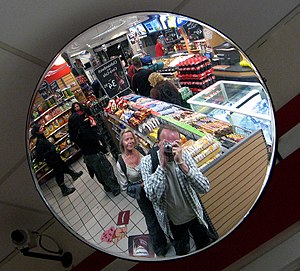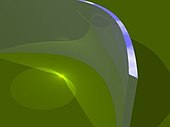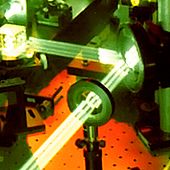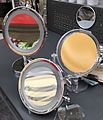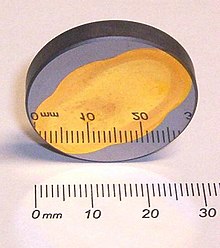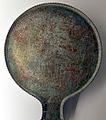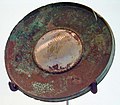mirror
A mirror (from Latin speculum "mirror, image" to Latin specere "see") is a reflective surface - smooth enough that reflected light keeps its parallelism according to the law of reflection and thus an image can be created. The roughness of the mirror surface must be less than about half the wavelength of the light. A rougher white surface also reflects all light, but this is scattered in all directions in a disorderly manner .
Invisible electromagnetic waves and sound waves can also be reflected on suitable surfaces (“ reflection ”).
The transparency and absorption (semi-transparent, non-transparent, wavelength-dependent transparency or absorption) of the mirror has an influence on the brightness and color of the mirror image. Furthermore, the entire energy is never reflected, there is always a loss - the degree of reflection is always less than 100%.
Properties of the mirror image
Plane mirrors (flat mirrors) provide a virtual mirror image of the same size. Corner mirrors deliver reversed, upside-down images.
The mirror image in a flat mirror gives a truthful or undistorted image of both lengths and angles. However, the mirror exchanges the side facing it with the side facing away from it. This changes the 'handedness'. If the observer wants to put himself in the position of his mirror image, it appears to him as if left and right were reversed - everything appears in the literal sense of the word as a mirror image. So it makes sense to interpret the wrong handedness as an exchange of right and left, which then leads to the apparent contradiction ( mirror paradox ) that, in contrast, the top and bottom are not swapped. In order to stay in this picture, one can formulate that the mirror does not swap left and right, but front and back.
If the gaze falls on the object through two mirrors, it reappears with correct handedness. Periscopes and SLR cameras take advantage of this phenomenon . With mirrors, one can only see oneself as one is seen by others by using an even number of mirrors in the light path.
If the mirror surface is not flat, the mirror image is distorted . With convex mirrors (curved like a spherical surface) the (virtual) mirror image always appears reduced. On the other hand, an enlarged (real) mirror image can be achieved with concave mirrors . The image is created in the focal plane that is dependent on distance and curvature. Wavy mirrors can be used to create distorted images like those found in curiosities or laughing rooms .
Forms and uses
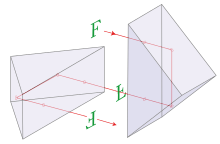
Mirrors can be divided according to their structure. On the one hand, there are mirrors for everyday purposes in which a transparent substrate is coated from behind. Today, a glass plate coated with aluminum is the most common, but silver is also used. The back of the metal layer is protected from oxidation by a layer of lacquer . In the past, mercury and tin were used . A protective varnish was not necessary here because the amalgam is chemically very stable. The cleaning of the visible side of dust , water marks and other dirt, e.g. B. by touching with fingers is occasionally necessary, but relatively uncritical.
In contrast, the optical mirror is a surface mirror : the reflective surface is applied to a carrier material at the front. This has the advantage that the boundary surfaces of the glass layer, which are crossed twice by the beam, are omitted and are therefore not able to produce shadow and multiple images. Disadvantages are the susceptibility of the open surface to corrosion and its mechanical sensitivity to scratching, especially for cleaning. Nowadays, aluminum is typically applied by vapor deposition for coating , which corrodes much less than silver and also has a comparatively flat spectral profile of the reflectivity at a high level. In some cases, a silicon dioxide layer is also vapor-deposited to protect against corrosion .
Another advantage of surface mirrors is that the carrier material does not have to be transparent, so that a larger range of carrier materials can be used. This enables further properties, such as B. fracture resistance or dissipation of lost energy can be optimized. Furthermore, surface mirrors can also be made from the full reflective material. Here only the surface is polished to a mirror finish , without any further coating.
Another variant of optical mirrors is realized by prism mirrors and beam splitters , in which the light falls through a flat glass surface into the rather large-volume glass body and is then partially or completely deflected in another direction on a slope using total reflection, in order to find a way to exit the vitreous again. Such a mirror does not need a reflective layer, but uses the boundary layer behavior of the material in which the light moves. Air is typically found on the other side of the boundary layer . In this concept, for. B. condensation, i.e. moisture on the interface, temporarily impair the function. The entry and exit areas, on the other hand, are only critical to a limited extent.
Plan mirrors
The best-known mirrors are the wardrobe and bathroom mirrors in the household. Float glass is mostly used for them because it is particularly plane-parallel. Optical plane mirrors are used in test setups and / or optical banks to redirect beam paths in other directions.
Plane mirrors do not create a real image of an object, such as a converging lens. The mirror shows an object standing in front of the mirror as if it were the same distance behind the mirror. As a result, the object is apparently further away for the viewer, so that it appears smaller because of the perspective . The actual image is not done by the mirror, but by the eye lens of the viewer; the mirror merely reverses the light beam paths.
Convex mirror
Convex mirrors are used as traffic mirrors in road traffic at blind intersections and exits. Its biaxial, convex shape enables a good view of the road despite the small mirror surface. Its mode of action corresponds to that of a concave lens , i.e. it maps the light from a wide image onto a significantly smaller field of view.
Rear and side mirrors on modern vehicles are often uniaxially convexly curved from a certain point in order to enlarge the viewing angle and thus reduce the blind spot .
Concave mirrors
Shaving and cosmetic mirrors are concave concave mirrors . Here the viewer is within the focal length and therefore sees an enlarged virtual image of himself , similar to a magnifying glass .
Concave mirrors or concave mirrors are also used for mirror telescopes . They create a real image of distant objects in their focal plane , similar to convex lenses . Compared to lens telescopes, however, there is the advantage that no chromatic aberration occurs. In addition, lenses that are too large are deformed by their own weight, so that only large or subdivided mirrors are used for telescopes with an opening of approx. 1 m or more - only they can be stored over the entire surface, be sufficiently thick and therefore sufficiently rigid. The shape accuracy of a mirror must be about four times higher than is the case with lens telescopes (cf. law of refraction , law of reflection ). Very large reflector telescopes also have adjusting elements on the back to compensate for possible deformations and imaging errors.
The imaging of spherical concave mirrors, i.e. mirrors in the shape of a spherical surface, is in principle subject to the imaging error of spherical aberration , except when an object is imaged on itself. If, on the other hand, rays arriving in parallel from the entire mirror surface are to be focused in one point, a parabolic mirror must be used in principle . In order to still be able to use a spherical mirror that is much cheaper to manufacture in telescopes, a sufficiently long aperture ratio is selected so that the error due to spherical aberration is smaller than other errors in the system, or additional correction lenses are used. For example, the correction plate according to Bernhard Schmidt (see Schmidt telescope ) is often found in telescopes in the upscale amateur sector.
To focus a point light source in a second point, the mirror surface must have the shape of an ellipsoid (example: light sources with ultra-high pressure mercury vapor lamps for photolithography ).
Parabolic mirrors are also used in solar thermal power plants to concentrate the sunlight on the steam generator and thus achieve the highest possible temperatures. Also car headlights contain parabolic mirror. In the case of projection headlights (cars, stages), a spherical mirror creates an image next to the filament. The light from the filament and the image are directed parallel with an aspherical lens located in front of it.
Other forms and uses
The magic used in optical tricks on the stage mirror, to let objects seem to disappear (picture below). Entertaining examples: see invisibility .
Distorting mirrors are deformed mirrors. Multiple distortions arise from undulating mirror surfaces . The sometimes bizarre effects were previously used in cabinets of curiosities and at annual fairs to amuse the viewer, today you can still find such mirrors in laughing rooms . Convex mirrors (curved mirrors) and concave mirrors have a reducing or enlarging effect. Distorting mirrors are sometimes used in clothing stores, which make the image appear slimmer: “ The mirror lies. "
Medical diagnostics use mirrors, for example, in endoscopes (hence the term gastroscopy ) and to inspect inaccessible cavities.
Mirrors in lasers and for their beam guidance and focusing have to endure particularly high power densities . Therefore, they either have to reflect particularly low-loss or they have to dissipate the resulting heat or be cooled. Using interference - and metal mirror . Fully reflective mirrors (end mirrors, focusing mirrors) and partially transparent mirrors (10 to 99.9% reflectance, e.g. for coupling mirrors and beam splitters ) are required .
A Cuban farmer's shaving mirror
Coatings of the surface
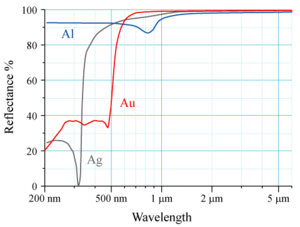
The type of coating allows you to specify the desired wavelength range with a high reflection factor:
- Metal coatings reflect well in the visible range (≈ 95%), but fail with silver and gold in the UV range, as can be seen in the adjacent picture.
- Dichroic dielectric mirrors (interference mirrors ) consist of several transparent layers with alternately different refractive indices on a glass substrate. They reflect only in a limited wavelength range and in a limited angle of incidence. They can be set up in such a way that they either reflect very well only in a very narrow wavelength range (≈ 99.9%) or, for example, allow the entire IR range to pass through (cold light mirror for halogen lamps).
Metals, plastics and even monocrystalline substances are also used as substrates . Criteria for the choice of substrate are its machinability, coefficient of thermal expansion, price and - especially with high performance - the thermal conductivity. All-metal mirrors made of copper are often used for material processing with carbon dioxide lasers .
Household and motor vehicle mirrors (exterior mirrors, headlights) consist of an aluminum layer behind glass or on plastic. In the past, silver layers were used for household mirrors, but these tended to tarnish and provide a slightly yellowish image.
Silver and gold layers, but also copper, are well suited for infrared . The reflection in the middle and far infrared correlates with the specific electrical conductivity of the metal used.
Aluminum or dielectric layers are used for ultraviolet .
X-rays can only be reflected by metals at a very flat angle to the surface ( angle of incidence ≈ 90 °) . The causes are the very short coherence length and the distance between the atoms , which is roughly the same as the wavelength. The apparent atomic distance is reduced by the flat angle of incidence.
For good imaging properties , a mirror (e.g. in single-lens reflex cameras , mirror galvanometers and mirror telescopes ), unlike household mirrors, must have the mirror layer at the front (surface mirror). In this case, the mirror layer usually has to be protected from oxidation and mechanical damage by a thin, as hard as possible, transparent cover layer.
Reflection gratings designed as mirrors are often referred to as interference mirrors ; they consist of a mirror layer provided with microscopic grooves. They are used in spectrometers and monochromators to separate individual wavelengths.
Partially transparent mirrors
Metal coating
Partially transparent metal-layer mirrors are based on a property that uncoated glass surfaces already have: they are partially reflective in a wide range of wavelengths.
Such partially transparent mirrors have a reflective layer ( silver , gold or other metals) on a glass pane that is considerably thinner (a few 10 nm) than a normal mirror, so that only part of the incident light is reflected and another part is absorbed or passes through unhindered.
Semi-transparent mirrors are also known as “spy mirrors” or splitter mirrors and serve as beam splitters : Part of the incident light is reflected, the rest is allowed through (absorption is neglected here). The respective proportions can be determined by choosing a suitable composition of the applied reflective layer.
Thin gold layers primarily reflect in the infrared, but are bluish transparent in visible light.
One-way mirror
See main article one-way mirror .
Dichroic mirrors
Apart from their rated wavelength, interference mirrors are always partially transparent. They have several transparent layers on a glass substrate, each with a different refractive index . The thickness of the layers is half the wavelength of the radiation to be reflected.
Interference mirrors only reflect in a limited wavelength range and in a limited angle of incidence, but achieve significantly higher degrees of reflection (> 99.9%) than is possible with metal mirrors (up to about 96%).
Interference mirrors can also be used as low-loss, partially transparent mirrors (beam splitters) and for splitting into different wavelengths or as color filters ( interference filters ).
Mirror in society
science
In behavioral research , recognizing one's own mirror image, which can be examined experimentally using a mirror test , is a sign of intelligence and the ability to abstract. Small children first have to go through elementary stages of development for this ability, while most animals are not even able to relate the image information of a mirror to themselves. In birds and other animals, the phenomenon of mirror fencers is known, who fight their own mirror image.
symbolism

The mirror is an extremely ambiguous symbol . On the one hand, it is considered a sign of vanity and lust . On the other hand, it also symbolizes self-knowledge , cleverness and truth : the origin of the saying "holding a mirror up to someone" or "mirror image of the soul", which is still in use today. In the eyes of some Christians, the mirror is also an attribute of Mary , because in her the image of God , namely Jesus, is mirrored.
In ancient cultures, the mirror stood as an image of the soul of a person, in which - depending on the mythological idea - the soul could also be captured and held. In ancient Egypt , the words "mirror" and "life" were identical. Celts were buried with their mirrors for the same reason. In Greek mythology , Dionysus ' soul is trapped in a mirror by the Titans . The reflection of his self-image held narcissist firmly on the water. In Buddhism , too, human existence is compared with reflection in a mirror.
In Jewish tradition, the mirror serves to explain the paramount role of Moses as a prophet. Maimonides compares divine revelation to the illumination of a night by lightning. Some prophets were granted the grace of such lightning flashes only once, and others more often, while Moses was part of continuous, uninterrupted enlightenment . The rabbis explain that his soul reflected the divine message as if from a clear mirror .
In the New Testament , the mirror is used by Paul on the one hand in connection with the rabbinical interpretation as a picture for the Christian knowledge of God, which is superior to Moses ( 2 Cor 3:18 EU ). On the other hand, the mirror (which at that time could only reflect dark and blurred as a shiny metal plate) serves as an image for the (in comparison to love) imperfect earthly knowledge:
“Now we look in a mirror and see only puzzling outlines, but then we look face to face. Now my knowledge is piecemeal, but then I will know through and through, just as I was also through and through. "
In many cultures, including the Central European world of legends, mirrors and supernatural knowledge ( fortune telling ) belong together. From antiquity to the early modern period, mirror prophecy ( catopter-romance ) was used. According to the folklorist Trachtenberg, even in the Middle Ages, Jewish scholars believed that looking in mirrors reflected the power of the eyes and thus strengthened them. Scholars have therefore put a mirror in front of them while they were writing. There was also something magical about making reflective surfaces.
In some monasteries , mirrors were banned in order not to promote vanity. In the Chinese tradition, the mirror was seen as a banisher of evil, because when evil looks in the mirror and sees its deformity, it is shocked . In the social setting this meant loyalty and in the spiritual view it was seen as an attribute of the wise man who expresses his mind like a mirror.
In Japan the mirror played a prominent role; he was one of the imperial treasures next to the throne and the sword. The Shinto tradition associates an octagonal mirror with the symbolism of the element metal and the cosmic epic about the sun goddess Amaterasu. According to legend, it was the mirror that made them come out of their hiding place and bring the light back to the world. The mirror that reflects the goddess and awakens her is thus the symbol of the world, of the space in which the apparition arises. The mirror is associated with the number “8” and with the symbol of divine perfection. The mirror is a moon symbol , because like the moon it is a reflection of appearance. The mirror is compared to the water and is used for divination and magical rituals among the peoples of the Congo, Bambara and Asia. The fortune teller sees the spirits in a bowl of water or in a mirror. In Old Russia, young women performed magical rituals with mirrors: On Christmas Eve, a large mirror was placed opposite a smaller one, with a candle in between. Then you asked the mirror to show your future husband, and when this became visible you had to quickly shout “God help me”, otherwise the double of what was shown would step out of the mirror and bring much evil to the woman who called him .
In the Middle Ages, the mirror was seen as a reflection of God's word and as a means of its interpretation. Wondering means having a mirror that reflects the divine laws and thus being able to recognize them. It is a means of observing heavenly bodies and the cosmos.
- In E. T. A. Hoffmann's collection of fantasy pieces in Callot's manner , subchapter: The Adventures of New Year's Eve , in the story The story of the lost mirror image, the protagonist Erasmus Spikher sells his reflection and thus his soul to his lover Giulietta, who is in league with the devil. (In the opera Hoffmann's Tales by Jacques Offenbach , Hoffmann does this himself.)
- In a story with the title Mirror Story , Ilse Aichinger tells the life of a woman backwards, starting with death and ending with birth.
- An autobiographical-poetic film by director Andrei Tarkowski is entitled Der Spiegel (1975) , and these always played an important role in his film language . (Tarkowski also planned to film about E. T. A. Hoffmann and, among others, The Story of the Lost Mirror Image .)
- The film Orpheus ( Orphée ) by Jean Cocteau shows the motif of the poet walking through a mirror into the afterlife.
- The book Alice in Wonderland by Lewis Carroll shows the mirror as the door to Wonderland.
- Herta Müller names a book with essays on her poetics The devil sits in the mirror . The saying comes from the grandmother, she writes, and is intended to warn against pride.
- The connection between death / devil and a mirror has been a vanitas symbol since the late Middle Ages, reinforced since the Baroque . In Daniel Hoffer's (* 1470; † 1536) woodcut, death and devil of the vain beauty appear in the mirror. A woodcut The Devil in the Mirror of the Vain Girl comes from the Ritter von Turn , Verlag Johann Bergmann von Olpe , Basel 1493;
- Grimm's fairy tale Snow White ; also with Rainer Maria Rilke , Nikolaus Lenau and Annette von Droste-Hülshoff in the motif of the doppelganger.
- Giovanni Segantini portrays Vanitá as beautiful, vainly looking at herself in the reflecting water.
Superstition
Mirrors have long been a common element of superstition or popular belief. Examples of this:
- If you break a mirror, you would be plagued by misfortune for seven years because there would be a doppelganger in the mirror. Should you hurt this, he would take revenge. One can also avert the misfortune by coloring the splinters black or by immersing them in running water.
- If you show a small child the mirror, it could become anxious or often sick.
- If you go out of the house and find that you have forgotten something, you should look into its reflection, otherwise you would encounter many obstacles on your way.
- In the house of the dead one should hang up all mirrors so that his soul cannot settle there and frightens the living.
- A woman should not look in the mirror if she is menstruating, pregnant or has just given birth, because this is when she sees her grave open.
- You shouldn't say anything bad in front of the mirror and you shouldn't criticize yourself, because it reflects what has been said.
- One should stand in front of the mirror every morning and ask him to throw back all the evil in the house and to protect everyone who lives in the house.
- You can recharge your energy with the help of the mirror if you look into your eyes for a few minutes, either in the morning before sunrise or in the evening after sunset. The explanation for this is that the sun attracts energy like a magnet.
- In the bedroom, the mirror should not reflect the sleeper if possible, otherwise one would sleep restlessly. The mirrors can also be hung up during the night. If one sleeps restlessly, one should put a large mirror under the bed with the mirror side down; he would throw back all influences on the sleeper into the earth.
- Vampires (who are themselves a superstition) have no reflection.
History of mirror manufacturing
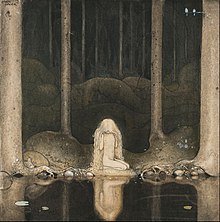
Development up to the end of antiquity
Static water surfaces are natural mirrors. The first artificial mirrors are likely to have been shallow bowls of water. Jewelry and body painting have been part of people since the Stone Age and with it the need to see the result of decorating and painting on oneself.
The first human-made mirrors may have been made as early as the Copper Age or the Bronze Age by polishing available metals for this purpose. Around 3000 BC There were already such bronze mirrors in Mesopotamia .
In Çatalhöyük , James Mellaart found mirrors made of obsidian . These consisted of a conically roughly hewn back and a flat front. This was polished smooth and is a bit convex. After the manufacturing experiments, the mirror surface was first roughly cut and then polished with coarse and fine grindstones, with sand, clay and water. It takes eight hours to make a mirror from an obsidian ball.
Etruscan bronze mirror from Volterra (325-300 BC)
Massive silver mirror from Pompeii (79 AD)
Mirrors made from polished bronze and copper plates are known from ancient Egypt . They have appeared in pictorial representations since the Old Kingdom and are well documented by finds, as they were part of the standard equipment of women's burials. These mirrors were round and had a handle that was usually made of a different material. Some of these handles are richly decorated. The first containers for storing mirrors also come from Egypt. All preserved specimens are hand mirrors.
The first written tradition of metallic mirrors in the Bible can be found in Exodus 38: 8: "And made a hand-barrel of ore and his foot also of ore from the mirrors of the women who served in front of the door of the tabernacle of the pen." Etruscan and Greek mirrors were often richly decorated with figural scenes on the back. Mirrors from ancient Greece often also had a handle that acted as a leg so that the mirrors could be set up freely. These legs are often made in the form of standing figures. In addition, in the 4th century BC The first folding mirrors, whose lids, which protected the mirror surface, are often richly decorated.
Over three thousand Etruscan bronze mirrors have been discovered mainly in tombs. They were made from the end of the fifth to the second century BC. Produced in Etruria . Mostly women used these mirrors, which were usually given to them at weddings and later placed in their graves. Freshly polished, these mirrors shine like gold according to tradition. Mythological scenes were often engraved on the reverse.
Roman mirrors often no longer have the long handle that was common in previous cultures, but these handles still occur. For example, a silver mirror with such a handle was found in Pompeii . Folding mirrors were also widespread and enjoyed obvious popularity. They could have a metal mirror surface or one made of glass. The Roman folding mirrors are usually smaller than the Greek ones.
The first mirrors with a mirror surface made of glass are described by Pliny and are said to have been invented in Sidon . Sidon is considered to be one of the most important places in early glass production, so this assumption can be justified. The oldest surviving specimens date from the second century AD. They are usually round. The glass is usually embedded within a metal surface.
middle Ages
Mirrors were first created in the 14th century by blowing glass spheres and adding metal alloys to them while they were still glowing. After cooling, these spheres were divided into sections and thus convex mirror surfaces were obtained. From the 14th century onwards, the carrier materials in which these mirror surfaces were embedded are mainly ivory mirrors or mirror boxes, whose manufacturing centers are in Paris, Cologne and the southern Netherlands. There were also small, cheaper to produce cast tin capsules, of which hardly any have survived. Small mirrors were also embedded in pilgrim signs , these were then also called "mirror signs " (also pilgrimage mirrors ). Other mirror frames were made of wood and are practically no longer preserved today - although inventories and pictorial representations give evidence of their existence; perhaps the most famous example is the mirror in what is called Arnolfini Portrait by Jan van Eyck , seem made of wood embedded in the several enamelled medallions.
Early modern times: Covering with tin foil using mercury
At the end of the Middle Ages the technology of glass mirrors was further developed and mercury mirrors were produced. It was mercury coated on thin, stored on paper, tin foil polished and covered with a further, smooth paper sheet. A glass plate was placed on top and pressed lightly, while the top layer of paper was removed again. The mirror was ready after 10 to 20 hours of resting and pressing and up to two weeks of drying time.
Since tin and mercury combine to form tin amalgam , tin amalgam level would be the correct name. The manufacture of these mirrors was much more complex than the manufacture of mirrors by blowing the alloy into glass spheres, but it was used for almost four centuries.
From the invention around 1450 to 1665, the production of clear crystal mirrors was a monopoly of the glassblowers on the Venetian island of Murano . Then twenty craftsmen were lured away from France and a royal mirror glass factory was set up, first in Paris and from 1695 in Saint-Gobain . This is where the first flat mirrors were made. In 1734 two square meters of mirror glass cost the annual salary of a glassblower.
Modern: coating with silver and aluminum
Finally, in the 19th century, the silver mirror was created. In 1835 Justus von Liebig published the lines: "[...] if you mix aldehyde with a silver nitrate solution and heat it, silver is deposited on the wall of the glass and a brilliant mirror is created." But only when amalgam mirrors were banned in 1886 because of their toxicity, there was a general transition to the manufacture of silver mirrors. For a more detailed description of the chemical relationships, see also: Silver mirror sample .
Today, aluminum foil is pressed onto smooth glass panes in a vacuum, or aluminum is vaporized or sputtered on them.
There are simple glass mirrors and more valuable crystal mirrors. These must contain at least ten percent oxides; either lead oxide (PbO) or barium oxide (BaO), potassium oxide (K 2 O) or zinc oxide (ZnO) (see also crystal glass ).
Related topics
- Physical considerations can be found under reflection (physics) , total reflection , transparency (physics) and lens (optics) .
- Optical children's toys are the kaleidoscope and so-called mirror games .
- The right-angled arrangement of several mirrors reflects light rays back to the source, see retroreflection .
- A blind spot is an area that cannot be seen, for example, by a rearview mirror .
- The mirror stage is the developmental phase in which a child first perceives himself.
- A heliograph uses a mirror to reflect sunlight back to a distant observer.
- The Schüfftan process projects a backdrop onto a stage.
- The hall of mirrors, which was built in the Baroque era, was intended to increase the impression of splendor, size and opulence through optical effects.
- Anamorphic distorted images are often rectified by cylindrical mirrors.
- The mirror paradox describes the question why a mirror apparently swaps right and left, but not above and below.
literature
- Jurgis Baltrušaitis: The mirror. Discoveries, delusions, fantasies . 2nd Edition. Verlag Anabas, Giessen 1996, ISBN 3-87038-283-X
- Erwin Jaeckle : The witch's monster of the mirror. An essay , Calatra Press, Lahnstein 1997
- Lambertus Okken: The glass mirrors in German-language literature around 1200. In: Janus 70, 1983, pp. 55–96.
Web links
- Flat mirrors - optical effects with mirrors
- Properties of a mirror image State education server Baden-Württemberg
- A short cultural history of the mirror at Monumente-Online
Individual evidence
- ^ MV Berry : Reflections on a Christmas Tree Bauble . (PDF; 1.1 MB) ( Memento from January 11, 2014 in the Internet Archive ) In: Physics Education. Volume 7, Issue 1, 1972, pp. 1-6, doi: 10.1088 / 0031-9120 / 7/1/301
- ^ Eef van Beveren, Frieder Kleefeld, George Rupp: Images in Christmas baubles. In: European Journal of Physics. Volume 27, Issue 2, January 19, 2006, p. 337, doi: 10.1088 / 0143-0807 / 27/2/016
- ↑ Joël Roerig: Shadow boxing by birds - a literature study and new data from southern Africa . In: Ornithological Observations , ISSN 2219-0341 . Volume 4, June 4, 2013, pp. 39-68.
- ↑ Fig. In Art. Segantini
- ↑ Carl Haberland: The mirror in the belief and custom of the peoples. In: Zeitschrift für Völkerpsychologie und Sprachwissenschaft 13, 1882, pp. 324–346.
- ↑ Egyptian mirrors
- ↑ Natural history . 36,193
- ↑ Gothic Ivories Project at The Courtauld Institute of Art, London: Gothic Ivories. In: Gothic Ivories Project at The Courtauld Institute of Art, London. The Courtauld Institute of Art, London, October 1, 2008, accessed on July 29, 2018 (English, For examples, enter "Mirror" or "Mirror Case" as search terms, there you will also find further literature).
- ^ Museum Bojmans van Beuningen, Rotterdam: Lid of mirror box. In: Accession number F 9012 (KN&V). Museum Bojmans van Beuningen, Rotterdam, 1994, accessed on July 29, 2018 (English).
- ^ Johanna Scheel: The old Dutch donor picture. Emotional strategies of vision and self-awareness . Gebr. Mann, Berlin 2013, ISBN 978-3-7861-2695-9 , pp. 320-353 .
- ↑ Kurmainzische Spiegelmanufaktur . In: Mensch und Wald - Leaflets for visitors . Spessartmuseum , Lohr am Main, 2002. See in detail Werner Loibl: The Kurmainzische Spiegelmanufaktur Lohr am Main (1698–1806) and the successor companies in Spessart , 3 volumes. Geschichts- und Kunstverein Aschaffenburg, Aschaffenburg 2012. ISBN 978-3-87965-116-0 , ISBN 978-3-87965-117-7 , ISBN 978-3-87965-118-4
- ↑ Fischer'sche Spiegelfabrik Erlangen, in: Nationalzeitung No 40, March 10, 1839
- ↑ GEO 10/2008, p. 72 ff., Gesa Gottschalk: Das reflected Ich
- ↑ See also Ludwig Hartmann: Faraday an Liebig (1858): On the history of the silver mirror production. In: Sudhoffs Archiv 32, 1939/40, p. 397 f.

